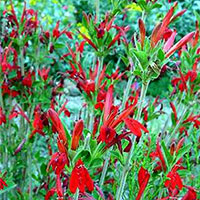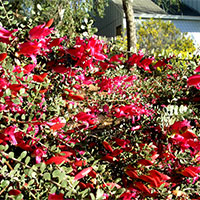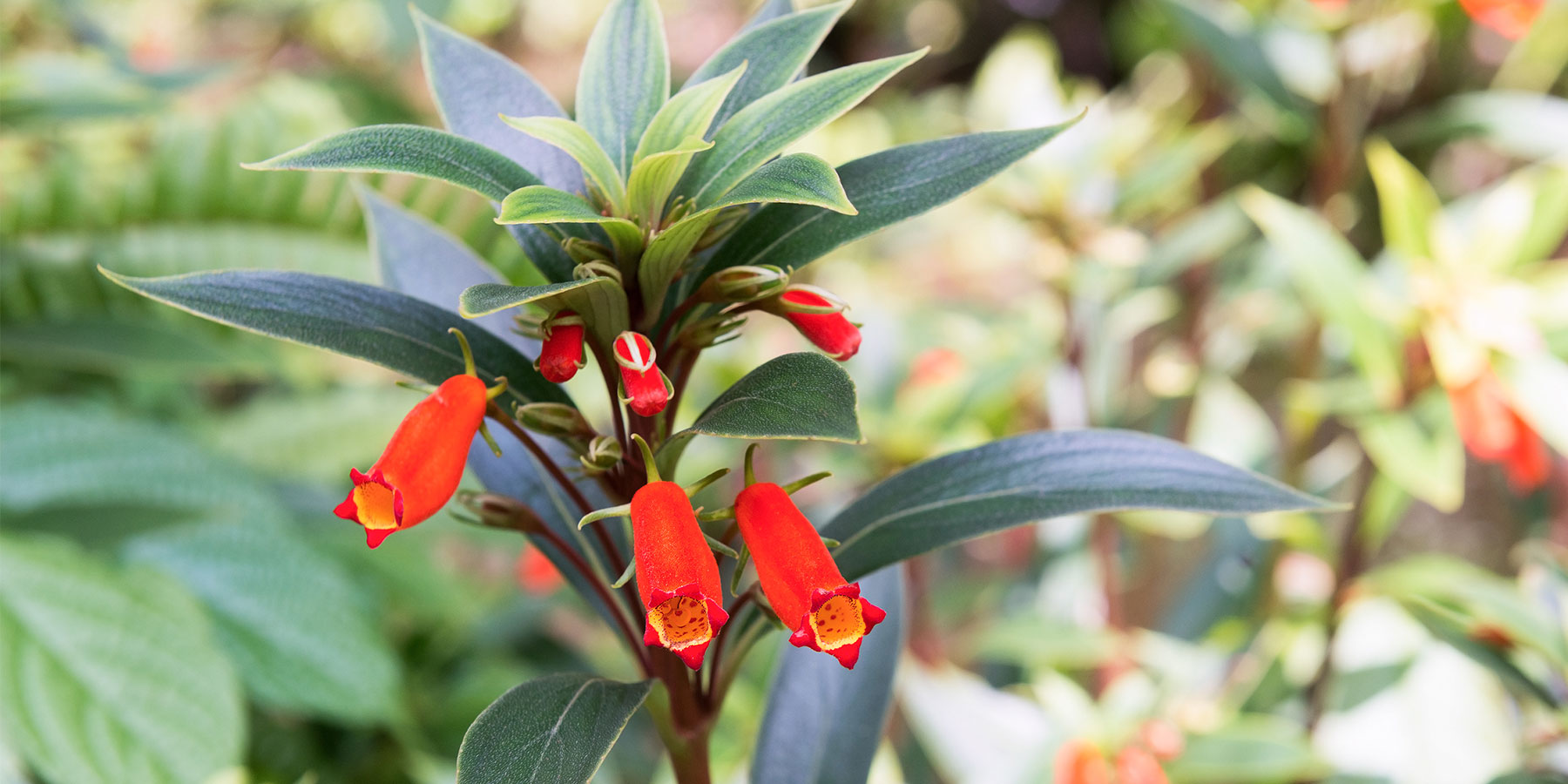Colorful Winter Plants and Shrubs for the Desert Landscape
Unlike most areas that are lifeless and devoid of color in the winter, landscapes in the Desert Southwest can be full of colorful winter plants and shrubs. Make the most of your outdoor spaces by adding some of these colorful plants for the desert winter landscape.
Chuparosa (Justicia californica)
 Chuparosa is a favorite amongst Southwest gardeners because it can bloom almost all year and is a big hit with hummingbirds. This smaller shrub with long branches and soft semi-evergreen leaves produces bright red tube-shaped flowers for most of the year (in cooler climates it may go dormant over the winter). Native to the Sonoran desert, this colorful shrub can withstand the heat, is hardy to 20 degrees Fahrenheit and needs little water. For those looking to create a hummingbird garden, this would be a great addition!
Chuparosa is a favorite amongst Southwest gardeners because it can bloom almost all year and is a big hit with hummingbirds. This smaller shrub with long branches and soft semi-evergreen leaves produces bright red tube-shaped flowers for most of the year (in cooler climates it may go dormant over the winter). Native to the Sonoran desert, this colorful shrub can withstand the heat, is hardy to 20 degrees Fahrenheit and needs little water. For those looking to create a hummingbird garden, this would be a great addition!
Blue Elf Aloe (Aloe x ‘Blue Elf’)
 Blue Elf (Aloe x ‘Blue Elf’) is a petite aloe that adds visual warmth to winter gardens with its blue-gray succulent leaves and contrasting deep-orange blooms. Hummingbirds are very attracted to the flowers which usually appear in mid-winter in low desert areas and continue into mid to late spring. Unlike many other types of aloe, ‘Blue Elf’ thrives in full sun or shade, and can also handle the cold to 15 degrees Fahrenheit. Blue Elf looks great planted along with golden barrel cactus (Echinocactus grusonii) for a welcoming combination or place near boulders in groups of three.
Blue Elf (Aloe x ‘Blue Elf’) is a petite aloe that adds visual warmth to winter gardens with its blue-gray succulent leaves and contrasting deep-orange blooms. Hummingbirds are very attracted to the flowers which usually appear in mid-winter in low desert areas and continue into mid to late spring. Unlike many other types of aloe, ‘Blue Elf’ thrives in full sun or shade, and can also handle the cold to 15 degrees Fahrenheit. Blue Elf looks great planted along with golden barrel cactus (Echinocactus grusonii) for a welcoming combination or place near boulders in groups of three.
Baja Fairy Duster (Calliandra eriophylla)
 Fairy Duster is a low spreading shrub that produces small flowers with dense clusters of pale to deep pink needle-like stamens that give it its unique look, which appears between late winter and late spring. Baja Fairy Dusters can handle the heat but bloom best when planted in full sun. and also attract butterflies and hummingbirds.
Fairy Duster is a low spreading shrub that produces small flowers with dense clusters of pale to deep pink needle-like stamens that give it its unique look, which appears between late winter and late spring. Baja Fairy Dusters can handle the heat but bloom best when planted in full sun. and also attract butterflies and hummingbirds.
Valentine Bush (Eremophila maculata ‘Valentine’)
 Valentine Bush (Eremophila maculata ‘Valentine’) is a variety of Emu Bush that begins to bloom its reddish-pink flowers in late December. As its name suggests, flowering peaks around Valentine’s Day and lasts into March. Once flowers have faded, the dark green foliage becomes a wonderful background element to any desert landscape. Around mid-May, when it’s no longer in bloom, prune the shrub back to half its size. If you prune at any other time you risk decreasing flowering for the next winter’s season. Valentine Bush enjoys full sun and is hardy to 15 degrees Fahrenheit. For a striking color contrast, pair with yellow flowering plants such as Cassia (Senna spp.) or Blue Bells.
Valentine Bush (Eremophila maculata ‘Valentine’) is a variety of Emu Bush that begins to bloom its reddish-pink flowers in late December. As its name suggests, flowering peaks around Valentine’s Day and lasts into March. Once flowers have faded, the dark green foliage becomes a wonderful background element to any desert landscape. Around mid-May, when it’s no longer in bloom, prune the shrub back to half its size. If you prune at any other time you risk decreasing flowering for the next winter’s season. Valentine Bush enjoys full sun and is hardy to 15 degrees Fahrenheit. For a striking color contrast, pair with yellow flowering plants such as Cassia (Senna spp.) or Blue Bells.
Blue Bells (Eremophila hydrophana)
 Blue Bells (Eremophila hydrophana) are another popular variety of Emu Bush with its silvery foliage and lavender-blue flowers that bloom late winter and last most of the year. Blue Bells will stay short and require little to no pruning, do well in full sun, heat tolerant, and are hardy to 20 degrees Fahrenheit. It’s quite lovely and when grouped with Valentine Bush can create quite a show in winter to spring color, though Valentine will begin to bloom earlier.
Blue Bells (Eremophila hydrophana) are another popular variety of Emu Bush with its silvery foliage and lavender-blue flowers that bloom late winter and last most of the year. Blue Bells will stay short and require little to no pruning, do well in full sun, heat tolerant, and are hardy to 20 degrees Fahrenheit. It’s quite lovely and when grouped with Valentine Bush can create quite a show in winter to spring color, though Valentine will begin to bloom earlier.
Angelita Daisy (Tetraneuris acaulis syn. Hymenoxys acaulis)
 Angelita Daisy (Tetraneuris acaulis syn. Hymenoxys acaulis) is a native wildflower for the Southwest and produces fragrant bright yellow, daisy-like flowers among mounds of green grassy leaves. In most climates, Angelita Daisy will bloom in the Spring and Summer but warmer desert climates will enjoy these flowers year long. These flowers attract bees and butterflies, can handle extreme heat, and are hardy to -20 degrees Farhenheit. Angelita Daisy can be used as ground cover, in containers, or in a large grouping.
Angelita Daisy (Tetraneuris acaulis syn. Hymenoxys acaulis) is a native wildflower for the Southwest and produces fragrant bright yellow, daisy-like flowers among mounds of green grassy leaves. In most climates, Angelita Daisy will bloom in the Spring and Summer but warmer desert climates will enjoy these flowers year long. These flowers attract bees and butterflies, can handle extreme heat, and are hardy to -20 degrees Farhenheit. Angelita Daisy can be used as ground cover, in containers, or in a large grouping.
Blackfoot Daisy (Melampodium leucanthum)
 Blackfoot Daisy (Melampodium leucanthum) is a white-flowering ground cover that blooms throughout the year with the most prolific flowering occurring late winter into spring and throughout the fall. Although it may not bloom in winter outside of the low desert, it thrives in both intense heat and cold which makes it suitable for all regions in the Southwest. The only pruning needed is to remove dead growth when visible. These durable flowers are also hardy to -20 degrees Fahrenheit. Blackfoot Daisy looks great when placed near Baja Fairy Duster (Calliandra californica) or Pink Fairy Duster (Calliandra eriophylla) for a beautiful late winter into spring “cottage garden” look.
Blackfoot Daisy (Melampodium leucanthum) is a white-flowering ground cover that blooms throughout the year with the most prolific flowering occurring late winter into spring and throughout the fall. Although it may not bloom in winter outside of the low desert, it thrives in both intense heat and cold which makes it suitable for all regions in the Southwest. The only pruning needed is to remove dead growth when visible. These durable flowers are also hardy to -20 degrees Fahrenheit. Blackfoot Daisy looks great when placed near Baja Fairy Duster (Calliandra californica) or Pink Fairy Duster (Calliandra eriophylla) for a beautiful late winter into spring “cottage garden” look.
Firecracker Penstemon (Penstemon eatoni)
 One of the most popular perennials found in desert landscapes is the Firecracker Penstemon (Penstemon eatoni). Its deep orange-red flowers add much-needed winter color and hummingbirds love them. In low-desert landscapes, blooms can start to appear in early winter and last long into spring while in colder regions, flowering will occur later in early spring. Firecracker Penstemon is hardy to -20 degrees Fahrenheit. To prolong blooming, cut back the flowers just as they begin to fade and you will often get a second flush of blooms. Plant Firecracker Penstemon in full sun near yellow-flowering plants such as Desert Marigold (Baileya multiradiata) or Angelita Daisy (Tetraneuris acaulis) for nice color contrast.
One of the most popular perennials found in desert landscapes is the Firecracker Penstemon (Penstemon eatoni). Its deep orange-red flowers add much-needed winter color and hummingbirds love them. In low-desert landscapes, blooms can start to appear in early winter and last long into spring while in colder regions, flowering will occur later in early spring. Firecracker Penstemon is hardy to -20 degrees Fahrenheit. To prolong blooming, cut back the flowers just as they begin to fade and you will often get a second flush of blooms. Plant Firecracker Penstemon in full sun near yellow-flowering plants such as Desert Marigold (Baileya multiradiata) or Angelita Daisy (Tetraneuris acaulis) for nice color contrast.
Feathery Cassia (Senna artemisiodes)
 Native to Australia, Feathery Cassia (Senna artemisiodes) adds delightful feathery texture with its gray-green foliage. In low to mid-desert gardens, fragrant golden-yellow flowers start to appear in mid-winter and continue to bloom into early spring. Feathery Cassia is hardy to 10 degrees Fahrenheit. Silvery Cassia (Senna phyllodenia) and Outback Cassia (Senna oliogophylla) are related species that do equally as well in the desert garden, as well as the more cold-hardy desert senna (Senna nemophila). Plant Feathery Cassia in full sun in clusters of three or more and use it as a naturally shaped hedge.
Native to Australia, Feathery Cassia (Senna artemisiodes) adds delightful feathery texture with its gray-green foliage. In low to mid-desert gardens, fragrant golden-yellow flowers start to appear in mid-winter and continue to bloom into early spring. Feathery Cassia is hardy to 10 degrees Fahrenheit. Silvery Cassia (Senna phyllodenia) and Outback Cassia (Senna oliogophylla) are related species that do equally as well in the desert garden, as well as the more cold-hardy desert senna (Senna nemophila). Plant Feathery Cassia in full sun in clusters of three or more and use it as a naturally shaped hedge.
As you can see, a colorful winter landscape is possible, so desert-dwellers rejoice!







